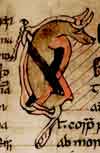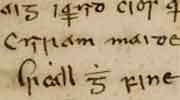
Gaelic manuscripts held in the National Library of Scotland date from the Middle Ages to the present time. The older manuscripts form the largest collection of late medieval Scottish Gaelic manuscripts in the world.
Our range of modern Gaelic manuscripts continues to grow as we add archives of literary authors and cultural institutions to the national collection.
You can consult all our Gaelic manuscripts in the Manuscripts Reading Room in our building on George IV Bridge. See the Special Collections Reading Room pages for details.
On this page
The beginnings of the Gaelic manuscript collections

During the 17th and 18th centuries only seven Gaelic manuscripts made their way into the Advocates Library, the predecessor of the National Library of Scotland. Four of these were unsolicited donations, the remaining three were bought in one lot from a financially troubled printer and bookseller.
But in the later 18th century, James Macpherson's Ossianic poetry sparked a new interest in Gaelic traditions. Greater efforts were beginning to be made to collect and preserve the written heritage. The 19th century therefore saw a significant expansion of our Gaelic manuscript holdings. The following collections were deposited:
- Highland Society of London: collection of Gaelic manuscripts
- Highland and Agricultural Society of Scotland: collection of Gaelic manuscripts and society archive
- MacLachlan of Kilbride manuscripts
- John Francis Campbell of Islay
- William F Skene.
A number of smaller private donations finally brought the number of Gaelic manuscripts up to 150 volumes.
The early Gaelic collections


Many of the early Gaelic manuscripts are composite volumes that contain a range of authors, subjects and dates. A large part is written in the classical language and script that was common to both Scotland and Ireland until the earlier 18th century.
The history of ownership of the volumes is interesting and varied and can often be traced back to members of the professional learned orders. About 17 volumes, for example, are associated with members of the Beaton family of hereditary physicians.
The subjects covered are those that are traditionally associated with Gaelic learning, including:
- Medicine
- Poetry and song collections
- History and genealogy
- Tales and legends
- Religious subjects
- Linguistics.
Among the highlights of the early collections are:
- The Book of the Dean of Lismore (Adv.MS.72.1.37)
- The 'MS 1467' (Adv.MS.72.1.1) with its famous clan genealogies. These are the subject of a detailed scholarly website about the '1467 manuscript'
- The Glenmasan manuscript (Adv.MS.72.2.3)
- Poetry of Alasdair Mac Mhaighstir Alasdair (Adv.MS.72.2.13)
Gaelic manuscripts acquired from 1925 onwards

whisky. View poem
page and details
In 1925, the Gaelic manuscripts were transferred to the National Library of Scotland from the Advocates Library. We have continued to build up the modern Gaelic collections, and to acquire individual items as well as some substantial archives such as the following:
- Archives of authors, such as Sorley MacLean (catalogued on line) and Christopher Whyte
- Papers of antiquarians, genealogists and collectors of Gaelic manuscripts
- Papers of Celtic scholars and fieldworkers such as William Matheson, professor at Edinburgh University (Acc.9711; view William Matheson inventory (PDF) (9 pages)
- Archives of Gaelic-related organisiations and publishers, such as
- Malcolm MacFarlane: view Malcolm MacFarlane inventory (PDF: 5 pages)
- Gairm Publications
- the Scottish Gaelic Texts Society: view Scottish Gaelic Texts Society inventory (PDF: 3 pages)
How to find manuscripts in our collections
There is no single catalogue available that records all our Gaelic manuscripts. Depending on the nature of your search, using a combination of finding aids as described below will usually lead to success. However, we are always happy to help with any enquiries.
Search strategies — older Gaelic manuscripts
- If you would like to know more about a specific manuscript and already know the reference number, you can find descriptions in Mackinnon's catalogue and in Black's catalogue.
- If you have a reference number but are not sure whether this is still valid, check the Gaelic reference number concordance (PDF) (35 KB: 8 pages).
- If you are looking for a certain author, check Mackechnie's catalogue. This will give you the NLS reference number and a short description. More details can then be found in Black's catalogue. If you are conducting your research from outside the Library with no access to either of these catalogues, Mackinnon's catalogue will also serve the purpose. It has to be used in conjunction with the Gaelic reference number concordance (PDF) (35 KB: 8 pages).
- for an overview of our holdings on a particular subject, Mackinnon's catalogue is the best starting point. The Gaelic reference number concordance (PDF) (35 KB: 8 pages) also lists, in very basic terms, the contents of our older Gaelic manuscripts.
Search strategies — manuscripts acquired from 1925 onwards
- If you would like to know more about a specific manuscript and already know the reference number, then descriptions can be found according to prefix:
- For manuscript numbers beginning 'MS.', check our printed catalogue volumes. Failing this, consult Mackechnie's catalogue (holdings up to 1977). Many descriptions of volumes with 'MS.' numbers are also contained in Black's catalogue. The Sorley Maclean manuscripts (MSS.29501-29798) have been catalogued on the online catalogue of manuscripts.
- For manuscript numbers beginning 'Acc.', check our Guide to Manuscripts Collections. If this is unsuccessful, please contact us.
- If you are looking for a certain author, society or other body, check the Guide to Manuscripts Collections or our printed catalogue volumes. Some of our holdings are also recorded on the National Register of Archives. Failing these, check Mackechnie's catalogue — although this only lists our holdings acquired up to 1977. If in doubt, please contact us.
- If you are looking for an overview of our holdings on a particular subject, contact us, giving details of your interests.
Catalogues and findings aids
The online catalogue of manuscripts records only the Sorley MacLean collection. You can access PDF inventories for some of the modern Gaelic collections through the Guide to Manuscripts Collections.
Mackinnon's catalogue, 1912
The first in-depth catalogue of our Gaelic manuscripts by Donald Mackinnon, Professor of Celtic in Edinburgh, entitled 'Descriptive Catalogue of the Gaelic Manuscripts in the Advocates Library, Edinburgh, and elsewhere in Scotland'. It is arranged by subject rather than by manuscript number and uses an older Roman numbering system. Its use as a catalogue is therefore not the most straightforward, but the descriptions of the manuscripts are scholarly and still valuable. For more on the numbering systm see the 'Note on reference numbers' section and the Gaelic reference number concordance (PDF) (35 KB: 8 pages).
You can find one annotated copy of this catalogue with cross-references to modern reference numbers on the open shelves in the Special Collections Reading Room. The Internet Archive also has Mackinnon's catalogue online. Our reference number concordance will allow you to identify both our modern reference numbers and the relevant pages in Mackinnon's catalogue.
Mackechnie's catalogue, 1973
'The Rev John Mackechnie's Catalogue of Gaelic Manuscripts in selected Libraries in Great Britain and Ireland' is often the best starting point in a search for a particular manuscript. It is a two-volume work that for the first time lists our holdings under their current reference numbers, and also includes acquisitions of Gaelic manuscripts from 1925 onwards. Its descriptions are far less detailed than those of Mackinnon and Black (see below), but its arrangement is more user-friendly.
We keep copies at the Special Collections Reading Room.
Black's catalogue (unfinished)
Professor Ronald Black of Edinburgh University compiled the most detailed and up-to-date scholarly catalogue of the Gaelic material. It is arranged in two parts comprising 'classical' and 'vernacular' manuscripts. The criteria for this division were linguistic (Common Gaelic versus Scottish Gaelic), palaeographic (Gaelic 'corra litir' script versus non-Gaelic script) and chronological (pre-1745 versus post-1745). Although publication is still intended, this valuable catalogue remains an unfinished typescript, wanting much of the 'vernacular' part as well as the introduction and index. Contact us for further information.
We keep copies of the catalogue at the Special Collections Reading Room.
Skene's scroll, 1861
The first list of the Gaelic manuscripts in the Library was made by William F Skene, who introduced a Roman numbering system which in 1925 was replaced by the present system. This list is of interest only with regard to the history of the collection. Skene never published it, considering it too rough and ready. Some newspaper cuttings are pasted in at the back.
We can issue Skene's scroll on request: quote reference number F.R.192.
A note on reference numbers
The Gaelic manuscripts had originally been considered a species apart by the Advocates Library, and numbered through in Roman numerals. After the foundation of the National Library of Scotland in 1925, all manuscripts formerly in the Advocates Library were re-numbered and given the prefix 'Adv.MS.' This was done to indicate their origin and to differentiate them from manuscripts received after 1925.
Under this new numbering system the Gaelic manuscripts were gathered together in the sequence Adv.MS.72.1.1 to Adv.MS.73.3.23. A few individual items can be found outside this sequence, and the Campbell of Islay collection is at Adv.MS.50.1.1-50.3.5.
An earlier reference to 'Gaelic MS.IV' now translates into 'Adv.MS.72.1.4', but things are not always as straightforward as this! Therefore if you are following up a Roman numeral reference number, see the Gaelic reference number concordance (PDF) (35 KB: 8 pages).
Gaelic manuscripts acquired after 1925 have the same reference numbers that are commonly used throughout the manuscripts collections. They begin with the prefix 'MS.' if fully catalogued, and 'Acc.' if not yet fully catalogued.
Useful links
- Website on the '1467 manuscript' by Ronald and Máire Black
- Dublin Institute of Advanced Studies: Bibliography of Irish Linguistics and Literature
- Early Irish Glossaries database
- Dublin Institute of Advanced Studies: Irish Script on Screen
- National Library of Ireland: list of Gaelic manuscripts
- Sabhal Mòr Ostaig Library
- Edinburgh University School of Scottish Studies: Archives and Library
